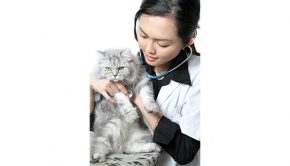Pooch Protocol, Good Manners Make a Dog Welcome
It seems dogs travel just about everywhere with their humans these days. They’re spotted at home improvement stores, happy hours, drive-through restaurants and workplaces, in addition to their usual hangouts. To get Sparky invited into even more people places, he must have good manners.
“Just like with kids, not every venue is appropriate for dogs,” advises Eileen Proctor, a pet lifestyle expert in Denver, Colorado. “Some dogs are more introverted and want a quiet spot to relax. Others love a party. Know your dog and socialize him accordingly; never force him into an uncomfortable situation.”
Instead, help him acclimate to new locales gradually, from a distance; stop when he shows signs of stress. A yawn, averted eyes, hiding behind his owner or nervous pacing are clues that a four-legged pal has had enough.
“Good manners at home might not translate to public manners,” Proctor notes. “Take practice runs to see how your dog handles distractions.” Day care or play dates with other dogs help hone canine social skills, while basic obedience—leave it, sit, stay, down, off, an effective recall and walking nicely on a leash—form the basis for good manners. Reward good behavior with praise, treats or a favorite activity.
Eating Out
Amy Burkert, the on-the-road owner of GoPetFriendly.com, says, “After a long day at the office or a ‘ruff’ week at work, it’s nice to include your dog when eating out. Pet-friendly restaurants with outdoor seating areas where the dog can join you are becoming more common, but always ask first.
“Dogs in dining areas should lie quietly under your table or by your chair,” she continues. “This is not the time to socialize. Diners may find it unappealing to be approached by your dog while they’re eating. Choose a table where your dog can be out of the way of customers and the wait staff.” It will take practice. “If he acts up, apologize, leave and know that you’ll do better next time,” says Burkert.
A good process for teaching good restaurant manners begins with sitting quietly with the dog when there are few people around, and then moving on. The next time, order an appetizer. Increase the amount of time the pet is expected to wait quietly, as well as the number of distractions.
Traveling Together
Christina Mendel, an international business coach with offices in Germany and Italy, adds that dogs need a safe and secure retreat from excessive activity. Her Chihuahua mix, Balu, is small enough to fit into a carry bag. He can take a nap, people watch or have a snack without fear of human interference. “The carry bag helps when I take clients to dinner, drive or fly to onsite appointments,” she says. “Many of my clients are dog owners, so we bond because he’s well behaved and knows tricks.”
Flying presents its own challenges because airlines limit the number of pets on each flight. Check the company’s rules for pet size, weight and type of crate required. Dogs ride as cargo unless they are small enough to fit in a carrier under the seat. Other passengers might be fearful or allergic, so respect their boundaries.
In the car, a dog needs to be calm and wear a special seat belt, be crated or otherwise restrained to keep him safe, not distract the driver and prevent lunging out the window.
At Work
Find tips for walking dogs in crowded urban areas at Tinyurl.com/RulesOfTheDoggyRoad.
Dogs may be welcome in the workplace. Alexandra Blackstone, design director for Killer Infographics, in Seattle, Washington, takes her corgi puppy, Buster, to the office. “He was good when he was the only dog at work,” explains Blackstone. “When an older dog and another puppy were there, he barked and tried to herd them.” He didn’t read other dogs well, so to further Buster’s dog-to-dog communication skills, Blackstone enrolled him in doggie day care twice a week.
She advises first introducing dogs outside of the office setting. “Communicate with coworkers as to what your dog is working on, so everyone is consistent in their behavior toward him,” Blackstone advises. “Be clear how to correct any inappropriate behavior if someone else shares responsibility for walking him.” She reports that with positive training techniques, Buster is learning to respond well and now splits his time between day care and the office.
“It’s your responsibility to make taking the dog along a good experience for all,” counsels Proctor. “That includes using a leash and always picking up after him, every time.”
Connect with freelance writer Sandra Murphy of St. Louis, MO, at StLSandy@mindspring.com.
<












